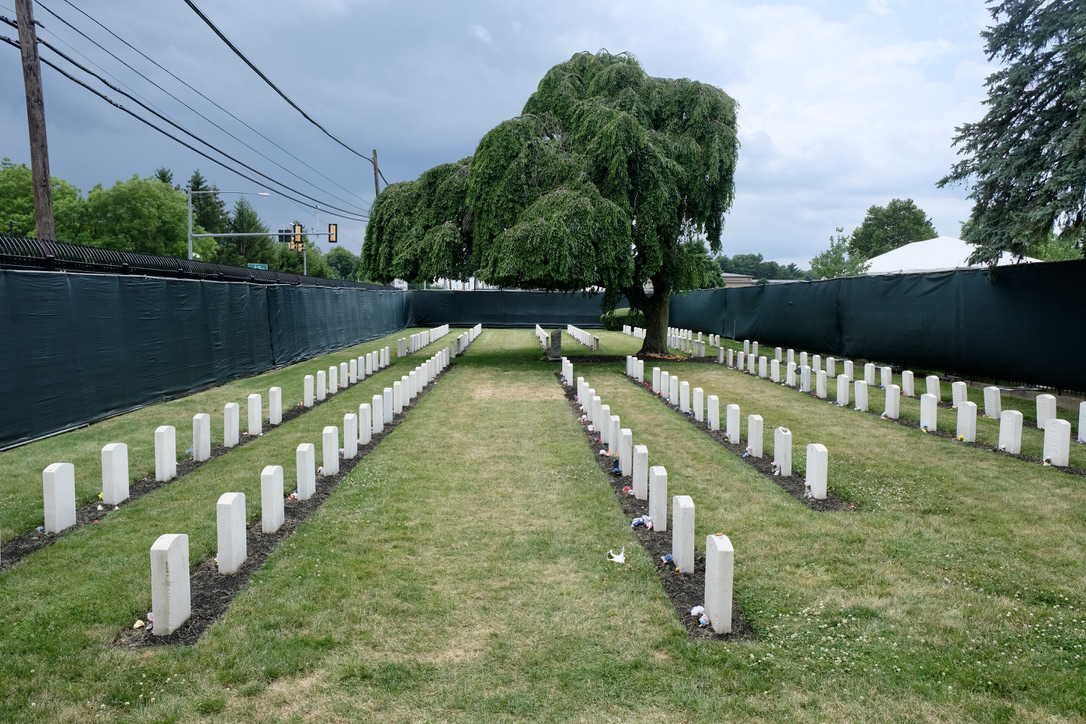
- Details
- By Jenna Kunze
Five Native American children who died more than a century ago at an Indian boarding school in Pennsylvania will be going home to their closest living relatives this September, the United States Office of Army Cemeteries announced in a federal notice on Thursday.
Those students include: Edward Upright, from the Spirit Lake Tribe in North Dakota; Amos LaFramboise, from the Sisseton Wahpeton Oyate of the Lake Traverse Reservation in South Dakota; Beau Neal, from the Northern Arapaho Tribe in Wyoming; Edward Spott from the Puyallup Tribe in Washington; and Launy Shorty from the Blackfeet Nation in Montana.
The disinterment of the five Native students’ remains will begin on Sept. 11, according to the Army. It marks the sixth disinterment and transfer of Native ancestors since 2017.
The students died in the government’s care between 1880 and 1910 while attending the nation’s flagship Indian boarding school, Carlisle Indian Industrial School, in Carlisle, Pennsylvania.
In 1879, Carlisle Barracks became the site of the nation’s first government-run Indian boarding school. Operating under the motto of “kill the Indian, save the man,” school administrators tried to forcibly assimilate 7,800 Native American children from more than 140 tribal nations through a mix of Western-style education and hard labor. Before it closed and the property was transferred to the Army in 1918, the school buried the bodies of at least 194 Indigenous children in the school cemetery, including 14 who are marked with “unknown” grave markers.
Many students’ deaths were announced in the local newspaper at the time, noting causes of death as “consumption” or tuberculosis, or detailing circumstances of unknown sickness. One teenage student, Edward Spott died of consumption in 1896, just eight months after he graduated, according to the local school newspaper.
“Edward was a bright young man, full of hopes and possibilities,” the article noted, among paragraphs about the goings-on with other students. “After graduation and before, he was a member of the preparatory school at Dickinson College and won many friends among students there. He was beloved by all who knew him and his death is exceedingly sad.”
One hundred and twenty six years later, Edward Spott’s 25-year-old relative, Tiauna Augkhopinee, will be traveling from Washington state to Pennsylvania along with her aunt to bring home her relative this fall.
Augkhopinee, who works in her tribe’s historic preservation office, found Edward was buried at Carlisle while researching her family history last August. She then independently pursued his return by following the Army’s protocol, having her grandmother sign an affidavit to prove she was Edward’s closest living relative.
She said that, while she hasn’t had much difficulty navigating the return process, she owes her easy experience to the expertise of her aunt and colleagues who helped her.
“If I was not 25, able bodied, with the ability to communicate and advocate for his return… this would be a very difficult process.” Augkhopinee told Native News Online.
The Army began exhuming and returning the remains of Native childrens at the request of their closest living relatives in 2017. To date, the Army has returned a total of 28 Native American and Alaska Native children home to their families in five disinterment projects since, though not without controversy.
Tribal leaders and attorneys have repeatedly critiqued and challenged the Army’s internal process for returning ancestors, saying it is more stringent, restrictive, and burdensome than the federal law they say applies: the Native American Graves Protection and Repatriation Act (NAGPRA). In 1990, Congress enacted NAGPRA to provide a process for federal agencies and museums that receive federal funds to repatriate or transfer certain Native American cultural items—including human remains—back to their respective tribal nations.
The Army maintains that NAGPRA doesn’t apply to the Carlisle Main Post Cemetery because “Individually marked graves located within the Carlisle Barracks Post Cemetery do not constitute ‘holdings or collections’ of the Army nor does NAGPRA require the Army to engage in the intentional excavation or exhumation of a grave,” they wrote in the Federal Register Notice published on Thursday.
But attorneys for the Native American Rights Fund (NARF) and one of the affected tribes, the Sisseton Wahpeton Oyate, have recently reignited the debate that NAGPRA should apply and the Army’s internal process is “inapplicable to the children buried at Carlisle Cemetery,” according to a letter from NARF.
For example, the Army’s policy provides no means of repatriation by a child’s tribe if a living relative cannot be identified, whereas NAGPRA allows for the tribal nation to claim a child.
In March, NARF and Sisseton Wahpeton Oyate’s attorneys sent a letter to the U.S. Army’s Department of Army Cemeteries urging the “expeditious repatriation” of the tribe’s ancestor, Amos LaFromboise, under NAGPRA.
But instead of consulting with the tribe on repatriation, as NAGPRA dictates, the Army published their intent to disinter Amos in September without any notice to Sisseton Wahpeton Oyate tribal officials, Amos’ relative, or NARF attorneys, the parties confirmed.
Sisseton Wahpeton Oyate tribal historian Tamara St. John—who has researched her tribe’s ancestors buried at Carlisle for more than six years in preparation for bringing them home— told Native News Online on May 25 that the Army continues to disrespect tribal sovereignty by leaving them in the dark.
“It’s clear to me that they are essentially ignoring the tribe's wishes, and they have proceeded without communication, and without a plan,” St. John told Native News Online.
When her office notified Amos’ relative, who is an elder, that Amos would be disinterred in September, his reaction was: What are the plans?
“Just because [Amos’ name is] on the National Register, doesn't mean that all the necessary things are going to happen,” St. John said. “My office, we're the people that know how to do this, and instead [the Army is] trying to force this responsibility onto an older person.”
Although tribes have waited for more than a century to bring home their relatives, St. John said the Sisseton intends to ensure that NAGPRA is followed, and tribal sovereignty is respected.
“We want to bring them home,” she said. “It's been far too long, but we want to do it right.”
More Stories Like This
Navajo Council Committees Tackle Grazing Enforcement, Code RevisionsU.S. Must Fulfill Obligations by Protecting Programs
50 Years of Self-Determination: How a Landmark Act Empowered Tribal Sovereignty and Transformed Federal-Tribal Relations
Trump Veto Stalls Effort to Expand Miccosukee Tribal Lands
Oneida Nation Responds to Discovery Its Subsidiary Was Awarded $6 Million ICE Contracts
Help us defend tribal sovereignty.
At Native News Online, our mission is rooted in telling the stories that strengthen sovereignty and uplift Indigenous voices — not just at year’s end, but every single day.
Because of your generosity last year, we were able to keep our reporters on the ground in tribal communities, at national gatherings and in the halls of Congress — covering the issues that matter most to Indian Country: sovereignty, culture, education, health and economic opportunity.
That support sustained us through a tough year in 2025. Now, as we look to the year ahead, we need your help right now to ensure warrior journalism remains strong — reporting that defends tribal sovereignty, amplifies Native truth, and holds power accountable.
 The stakes couldn't be higher. Your support keeps Native voices heard, Native stories told and Native sovereignty defended.
The stakes couldn't be higher. Your support keeps Native voices heard, Native stories told and Native sovereignty defended.
Stand with Warrior Journalism today.
Levi Rickert (Potawatomi), Editor & Publisher

